Text
The Power of Tourmaphite

12 notes
·
View notes
Text
The Daily Visitor

1 note
·
View note
Text
Concealed

4 notes
·
View notes
Text
View from the Window

0 notes
Text
‘Shelog Dikk’ (Creative learning activity) for Heritage Museum Laspur- Laajverd Visiting School 2018

A year ago, I got an opportunity to visit a village named Harchin (a village in Laspur Valley, Upper Chitral) through Laajverd Visiting school. I had never heard of this place before and was curious to know about it. The local people were humble, generous and hospitable. I got a chance to have traditional food that was prepared by the locals. There were mouth-watering dishes! One of the most memorable experiences of this trip was listening to traditional music and engaging with the local community.
During my stay in Harchin, I participated in a session facilitated by Batool Ali regarding the museum as a learning platform for young children. The new heritage museum has a collection of unique historical artifacts collected by Amirulla Yaftali, one of the best polo players from Laspur Polo team.

My team and I started to design learning activities using historical artifacts. We collaborated with local school children when designing these activities.

By designing a game titled 'Shelog Dikk' (Storytelling), the children got to explore artifacts at the museum while creating stories around them as well as adding cultural references to the stories.
The objective of the project was to make children relate to the historical artifacts that belong in the Heritage Museum in Laspur Valley. This game can help school children to interact with the unique historical artifacts by themselves. This can also be useful for future researchers and local (Chitral) school trips. Developing stories can be very helpful in tapping into a child's imagination and enhancing creativity.
Once we were back in Islamabad, my team members decided to try out the activity in ‘paper fortune teller’ format. One of the team members explained, “This way kids can make two stories and they can play the game with other kids too.”
I worked on developing the first draft as a sample for this activity.


Zeeshan Ghani worked on developing the digital version for this activity.


Whether it’s about listening to folklore such as an apricot tree is occupied by fairies and other supernatural powers or listening to a lady talking about her animals named ‘Mikiniah’ and ‘Shaman’, I enjoy collecting stories from different valleys of Pakistan. Moreover, these experiences have helped me grow as an artist.
2 notes
·
View notes
Text
Artist in Residence Program in Fukuoka, Japan
A July resident at Studio Kura, I got interested in collecting Japanese folklore especially the ones about Yōkai (spirits).
I was lucky to come across a Japanese/ American girl named M. We talked about Japanese cuisine, shrines and the rural areas of Japan. One of the exciting conversations, I had with her was regarding the Japanese folklore about the mochi-making rabbit living on the moon. Enthusiastically, I shared that my father always told me that there is an old lady spinning yarn on a spinning wheel on the moon.
Inspired by the folklore, I drew a rabbit pounding mochi and then ...

an 8-year-old boy named K drew out the rest of the story. He later explained in Japanese that the rabbit picked strawberries and flew over the sea. Then, he made strawberry mochi. He pointed towards the next drawing and added, “He is drying the strawberry mochi. He is giving two mochis to his friend. He ate himself and gave one to another friend. He is tired now, so he is sitting on the chair. He starts to make mochi again.”
I also designed a character and asked people belonging to different age groups to continue drawing the story.



The three participants perceived the same image in different ways. Once they were done drawing their bit of the story, I asked them if they could explain why they drew those images. F san described the character as “The crab baby came from the crab moon. This person is not happy. He needs love.” Moreover, Y san explained the drawing as “A baby is Syria...escaped from the bomb attack. That’s a sad baby! The iron hands are protecting the baby.”
While doing this project, I made a few observations. Firstly, everyone has their own imagination and perception. Secondly, since there was a language barrier at times, drawing served as a common language during the activities. Thirdly, the children were spontaneous and more confident in expressing themselves than the elders.
A few pictures from the exhibition day.





0 notes
Text
July 2017
29/07/2017

A month in Japan felt like a dream. A beautiful dream.
I will cherish these sweet memories forever. It includes all these moments: Eating dango for the first time. Going to Dazaifu Tenmangu summer Tenjin festival. Having shaved ice. Having mochi. Entering the Ghibli shop. The sound of the ocean. Insects that sound like pressure cooker. Crabs. Dragonflies.
0 notes
Text
Crawlers and Stalkers
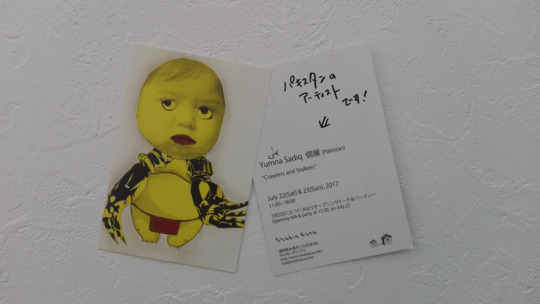
Have you ever had this feeling of something or someone watching over you?
When cycling along the rice fields or walking through the magical landscapes that remind one of Hayao Miyazaki’s animations, the feeling of something watching you is always there. But the question is… is it Ojizou sama watching over you or is it a tiny crab hiding under one of the rocks?
3 notes
·
View notes
Text
Space Exploration
20/05/2017
A few weeks ago, nine years old artists created a model of the Solar System in the art class while learning about the different components of the Solar System and characteristics of planets.

F who always comes up with creative ideas asked me, "Can we now make our own movie about space?" His eyes shone with excitement as he heard "Yes!" Together F, S, N, A, R and M worked as a group to make a short stop-motion animation on space.
They wrote a script...

They enjoyed every minute of it...
Video stills:



I love how N explained that "I had fun making this video because we were all directors."
Later, learners filled the reflection sheet and came up with more innovative ideas...

It was wonderful to see talented artists co-operating well to make an awesome fiction movie!
2 notes
·
View notes
Text
How did you get the idea of making soup cans?
18/05/2017
Central Idea: How Pop artists critique society through their work and how its' specifically responded to, by incorporation into consumerism
Today it was fun impersonating Andy Warhol- Painting my hair white, wearing his iconic sunglasses and holding an empty can of Campbell's soup...


At 9:30 am, seven years old artists had a conversation with Andy Warhol!
"How do you get the idea of making so many things in one time? How did you get the idea of making soup cans?Why do you love art so much? What else did you paint? Why do you use different colors in your art?" were some of the questions they excitedly asked Andy Warhol.
Inspired by Andy Warhol, they drew a popular product of their choice and repeated the image four times.


At the end of the class, M smiled and handed me a note that read:

Later in the day, S ran towards me, a twinkle in her eyes and expressed her thoughts in the following words-"Miss Yumna! You were on a vacation and you know...we met ANDY WARHOL today. It was so much fun!"
I LOVE the way, they interviewed Andy Warhol. It was interesting to have the following conversation:
M: But I think Impressionist paintings were better!
A: No! I like those ones more. (She quickly pointed towards the Abstract Expressionist painting)
Andy Warhol: How can you say one style is better than another? You ought to be able to be an Abstract Expressionist next week or a Pop artist, or a realist, without feeling you've given up something. I think that would be so great, to be able to change styles.
0 notes
Text
Why can't they live in fake trees?
In the first lesson, learners' prior knowledge regarding endangered animals was documented. They were shown 2 minute videos on endangered animals such as Cotton- Top Tamarin, Diana and Roloway Monkey. Also, we discussed about endangered animals in Pakistan such as Eagle Ray, Mountain weasel and Asian Black Bear.
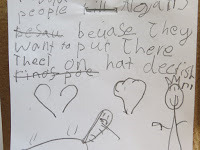
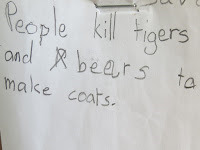
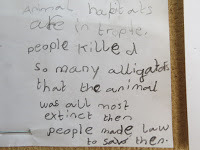

Learners were divided into groups to make a collage of an endangered animal of their choice.
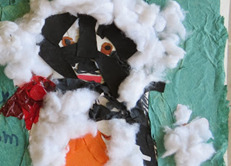
They were introduced to Andy Warhol's 'Endangered Species'-screen prints on endangered animals. I love the way they were curious about the butterfly in particular which made me go home and search about Silver spot butterfly.
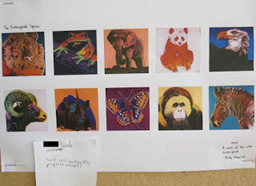
At the end of the lesson, we discussed about making comic strips on endangered animals. S asked about why do we have to make comics (which are supposed to be funny) on endangered animals while A was curious to know about 'why can't Cotton-top tamarins live in fake trees', if their habitat is being destroyed to construct roads and houses.

In the next art class, A excitedly read some pages from her personal diary regarding the information she had collected about Bengal Tigers.
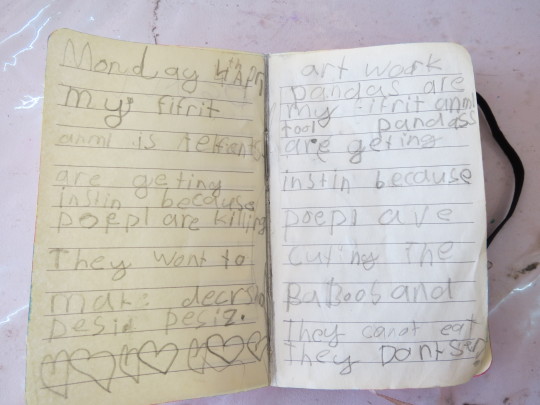
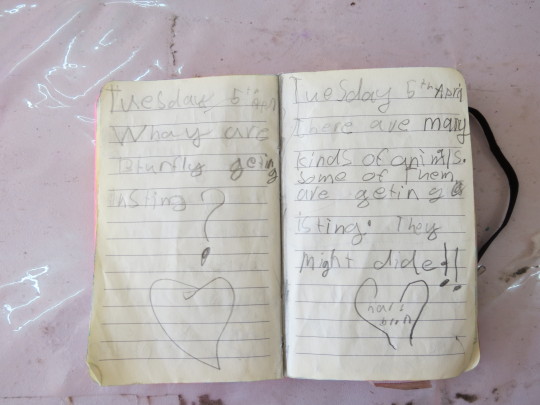

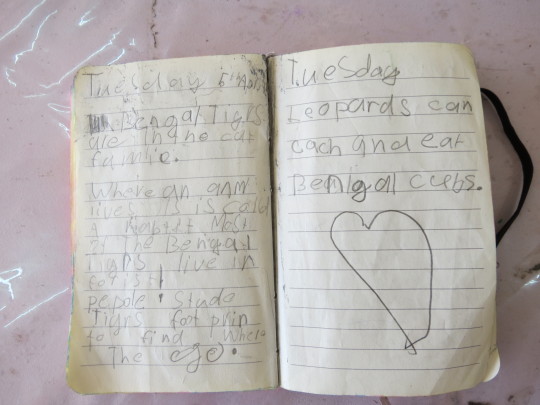
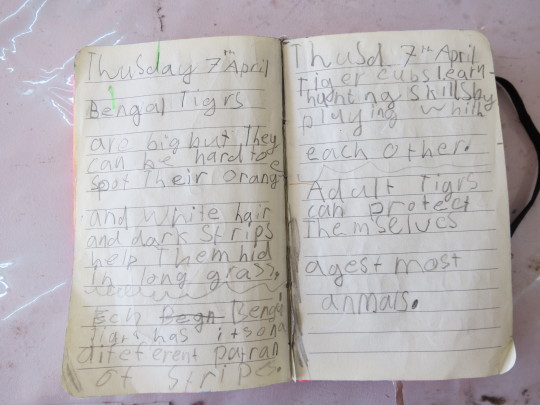

We discussed about characters, setting, panels, sounds, speech and thought bubbles, and comics with just visuals. Learners talked about Pakistani superhero comic book named Pakistan Man. They shared their interest in storytelling. A group of learners decided to make a comic strip on quagga.
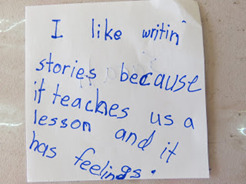
The discussions during the art lessons led up to questions such as do we need zoos? Even if scientists try to bring certain animals back from the dead (De-extinction), will we as humans take care of them?
Year 2016
3 notes
·
View notes
Text
America aur Islamabad may suba hai
02/04/2017: Do you remember the movie 'Hook' starring Robin Williams?
I remember my favorite part was where Peter Pan discovers that he has to imagine the food in his empty plate and bowl. As soon as he imagines the food, the empty plates are suddenly filled with delicious food and scrumptious neon colored cakes. So without imagination, the food doesn't exist.
There have been such moments in the past where I have experienced this kind of a Peter Pan moment.
A few months ago, six years old learners were learning about how artists use natural resources in their daily lives in a variety of ways. During one of their art activities, they made lots of bowls using the paper mache technique. Once they were finished painting it, they started talking about what they found interesting in each other's bowls. I still recall how M excitedly shared his view on one particular bowl - he described it as having “colors of the beach" in which blue represented the sea, brown- the sand, orange- the sun and green- the seaweed.

I absolutely LOVED the way he described the paper mache bowl!
A few weeks later, five years old artists were asked to make a daytime scene using the collage technique for the unit of inquiry, 'The Earth's natural cycles influence the activity of living things'. Everyone created different activities that occur during the daytime. F.A, upon completing his collage, cheerfully described the scenario in his artwork as "America aur Islamabad may suba hai. Islamabad may kite urr rahi hai."

This week I was having a conversation with F, a nine year old learner, regarding artists, art and art supplies. She added "My favorite painting in the world is 'The Starry Night'. It's about the feeling of stars. They are happy! Look at their colors."
Whether it's M describing the colors of the paper mache bowl, F talking about 'The Starry Night', or F.A explaining two different places in his painting, I believe it's all about one's perception and imagination!
0 notes
Text
It can turn his face because of this wood!
30/03/2017: "Don't let my rules pull you back from how you want to go ahead with your performance!" replied K.O, my wonderful teacher at Funen Art Academy Denmark, as I asked him some questions regarding stand-up comedy and discussed how I'd be performing my act in the next class.
Now that I'm an art specialist, his words still echo in my ear. Last week, nine years old artists were busy making a habitat of their favorite animal. They excitedly worked together as a team to make habitats of animals such as Red Panda, Cheetah, King Cobra etc and used art supplies such as cotton, clay, crepe paper, stones and leaves. F enthusiastically shared that "Red Pandas live in China and live inside a hollow tree! They look like raccoons". She pointed towards the picture of a Red Panda and I told her that I had never heard of it before. I think that's the BEST part about being a teacher - you get to be a lifelong learner!
I looked around the classroom and observed how Z was busy creating the narwhal with clay. While having a discussion about creating the tusk of the narwhal with a shashlik stick, W who collaborated with J and A to create a cheetah's habitat exclaimed "Look what J made!"
J quickly ran towards me and said "I made a cheetah. It can turn his face because of this wood and it can turn his foot! I made it with wood and clay. I had difficulty with it but I just made it!"



His eyes were twinkling with joy as he showed me how he could twist the cheetah's head and leg. I was amazed to see how he had come up with such a brilliant and creative idea of using the shashlik sticks.
At that moment I thought to myself that an artist is like an explorer of the universe, who gets to explore new places through imagination and creativity, but if constrained, would not be able to experience the joyous ride of exploring the mystical and mysterious universe.
3 notes
·
View notes
Text
Like we draw but he uses objects instead
24/10/2016: As an art specialist teaching at Headstart School, it is exciting to see how students perceive different art works, express themselves through art and are curious about everything and anything!
A few days ago, I was talking to a friend of mine and showed him a few of my students’ drawings. We talked about their unique drawing styles and compared it to how we were ‘taught’ drawing in our art college. Did we really need those drawing classes especially figure drawing classes? Was it a 'bad’ drawing if I didn’t make a proportionate figure? I ended up telling him “I so wish I could draw like them!”
I experience many magical moments! Like a few days back, eight years old artists were introduced to the 'Readymades’ of Marcel Duchamp and were asked “But is it art?” to which A quickly replied “Yes! He used objects to make art! He joined objects to make something different. Like we draw but he uses objects instead.” I was astonished to hear her answer!

Bicycle Wheel by Marcel Duchamp
Last week, seven years old artists were asked “Can you go around the art class and pick an item that you think is art?” “Oh YAYY!’’ shouted one of them and started to explore the shelves in the art class. They picked an item, wrote the name of that item on a sticky note or drew a drawing of it and excitedly came running towards me. "It has a butterfly and a flower. It has a design on the roof and a number plate!” explained R who was holding a tiny model of a rickshaw.
H on the other hand picked an empty plastic bottle (covered with paint) and opened and peeped inside and said “It is colorful and nice from inside. It has the color brown. It smells like 7 Up!” I loved the way he peeped inside the bottle and also asked me to look inside. I got surprised to see beautiful patterns inside it… and then it occurred to me that I never even once bothered to peep inside the bottle even though it has been lying in my art room for a long time!

One of my teachers once defined artist as an 'investigator’. I’m glad to be surrounded by little investigators every day!
3 notes
·
View notes
Text
Laajverd Visiting School: Doga and Doda (Local games to relive folklore)
Date: 2/12/2015
I'm in Ringe. Attending LARP. Had dinner. Attended 'Character writing workshop'.
Date: 2/14/2015
Yesterday, it was my first 'LARP'. Black box. White Death. It was a non-verbal LARP. The focus was a lot on the body language... gestures...movement. I got to play a 'two-dimensional character who constantly had to point his arms, legs, and feet in different directions'. After the game ended and I had to say goodbye to other role players...one of them told me that "you scared me!"
I have attended some talks and workshops. They were a bit of an introduction for me to this world!
I think people here are like these walking talking characters in the real world. One guy had a black feather stuck in his hair. One dresses up like some Victorian-era guy. One guy was wearing a steampunk hat. I also came across someone, who had a HUGE tattoo of Hulk on her leg... like some kind of huge comic book pages printed on her legs and arms.
People are friendly here. This world has a language of its own- campaigns.immersion.bleeding.
The characters do follow some rules and then they evolve as the game moves on.
I loved the workshop titled 'The emotions in your physics'! I like the fact that by taking a single body movement and gesture...repeating it... faster every time...you transform into something else...like I came across a girl who at one point had widened the space among her legs to such an extent that she looked smaller...in that very space she had transformed into another character.
Date: 8/25/2015
I got an opportunity to participate in Laajverd Visiting School, a cross-curricular and interdisciplinary program which is conducted in sites of post-disaster and conflict. This year the area being visited was Neelum Valley that lies on the Line of Control. Line of Control is the line that marks where the region of Kashmir is divided. This Line of Control suffers from ceasefire violations. Since parts of Neelum Valley have faced natural disasters like earthquake, floods, avalanches, and landslides and geographically, along the Line of Control, its people have faced continuous crisis and trauma. Keeping this in mind, I took it as an opportunity to introduce live action role-playing game (LARP) to the locals in Kel, Kashmir. I participated in Knudepunkt, a LARP conference in Denmark and found it to be very beneficial for an individual as well as for the society as a whole.
LARP is a role-playing game where participants play out characters according to the story that is part of a fictional universe. The participants have to follow a set of rules that evolve as the game progresses. Participants take on the role of different fictional characters and interact with a given environment which gives everyone a chance to take on the role of a leader. This way a shy and traumatized person can be transformed into a strong individual. I learned that LARPing includes people of all age groups and the main purpose is to work together to complete a task. By completing tasks in the game, a participant gets encouraged to face successfully, a difficult situation in the real world. Furthermore, I learned that Educational LARP is being used as a teaching method in schools around the world. The method used is to implement playful learning in the classroom environment where students learn lessons through interactive experiences embedded within conceptual narratives. For example, an 8th grade class in urban Los Angeles was asked to take on the role of a police detective or forensic scientist by using science facts to solve different mysteries. LARP can also help in transforming the environment in classrooms that can often be filled with anxiety and loneliness into a more playful scenario.
While carrying out field visits in Kel (a village in Kashmir), Batool Ali and I learned that boys play games like cricket, hockey, football, and Doga (a local version of hopscotch) while girls play Doga, Panj geetay (five pebbles), climb trees and some play with dolls. As we played hand-clapping games with little girls where we had to sing the English alphabets, we found out that not everyone goes to school and so some games could only be played by those that were part of an educational system. Educational LARP could not work in this context since we thought of creating a game that wasn't just for children going to school.
We had to understand children’s imagination so that we could design a LARP and create a universe around that. We had different conversations with children and through that, we learned that they were interested in mythical stories that exist in Kashmir. They talked about jinns1 and believed that they exist in Mosques, empty houses and in the jungle. They told us that jinns exist in different forms and sometimes also come in the form of a cow or a dog. We noticed how girls had fewer play-time activities than boys. They played a game called Doga that was a bit similar to hopscotch. Here the player has to drop a stone on one of the eight squares drawn on the ground. He/she has to hop over the squares and kick the stone from the first block till the last block for the game to finish. The participants use a 2 by 2 inch smooth round stone called tikki in the local language.

The eight squares have names such as Pail, Duja, Teeja, Jantu, Ogra, Dharni, Seriya and Samandur. They are named after numbers ranging from 1 to 7 while Samandur means sea. They could rest both feet on the square titled Ogra. As we started to understand the local context, the idea about LARP changed and instead we decided to improvise the game Doga by embedding a dying folktale. We decided that we can encourage children to design a creative activity that could become part of their everyday life. On the other hand, LARP requires participants to wear costumes and have props. Our aim was that children should be able to use inexpensive materials available in the local market.
We discussed and explained our idea with children of age group ranging from 9 to 14 years who immediately started to draw squares on the floor of the veranda. They drew out 36 squares from limestone powder. The children also added some safe and danger zones to these squares. They marked three separate squares as danger zones and named them Suraj (Sun), Saanp (Snake) and Sher (Lion).


These squares were marked as ‘Chashmas’.
We divided the group of children into two teams. One team called themselves Jeeto Pakistan (Win Pakistan) while the other team named themselves Neelum Club. We made wrist bands out of pink and yellow colored waistbands (kamar band) as it was a cheap material easily available at the local market.

The game was based on the mythical story around jinns possessing people and if they drink water from 7 chashmas (natural water spring), they will be able to get rid of them. Based on this story, 7 squares were marked as chashmas and 5 stones were randomly placed. The participants had to quickly hop and pick up the stones. The winning team had to collect a maximum number of stones.

The next day the group of children had found an empty room which they could use for playing purpose only and started to draw out the game again. This time they drew out 30 squares and named this game ‘Doda’ meaning loquat. Also, we kept 5 stones on 5 chashmas since we wanted to embed the mythical story of jinns and fairies who protected the water bodies in Neelum Valley into the game. They kept the names of the eight squares same as before while they named the remaining squares after the following fruits and animals.
Pail = One
Duja = Two
Teja = Three
Jantu = Four
Ogra = Five
Dharni = Six
Suraj = Sun
Seriya = Seven
Iklu = Name of a local fruit
Glas = Name of a local fruit
Hen
Tuka = Corn
Chota = Apple
Sholchi = Plum
Khor = Walnut
Sunjali = Name of a local fruit
Bronti = Name of an area in Kel
Saanp = Snake
Green Valley Guest House
Sher = Lion
Makhori = Honeybee
Samandur = Sea

The objective of this project was to bring a positive change in the lives of the children living in Kel.
This new game Doda gave a chance to children of Kel to play together as teams competing with each other which also promoted team spirit, healthy competition, and good sportsmanship. It also helped to build social skills as they played together and enjoyed each other’s company. Another innovation was that both boys and girls were involved together in playing this game while in the past Doga was played by boys and girls separately. We also encouraged the girls to become team captains that made them feel more confident and enthusiastic.
Also, playing helps to develop cognitive skills in children as it involves remembering, problem-solving skills, reasoning, and thinking and decision-making skills. As children developed Doda and its rules, it was a good way for them to learn to follow instructions, play fair and work to be a good winner. The game Doda is a reflection of the local, social and cultural context in which the children of Kel live. When playing a child learns to take risk, question and explore and while exploring it helps them to build up ideas, concepts, and skills. Therefore, this approach of designing creative activities is helpful for children in developing their self-esteem as well as their emotional, cognitive and physical development.
We found that our approach was useful in teaching children how to interact and communicate with each other. As they have to follow rules, wait for their turn and compete with each other, they learn to think, solve problems as a team, listen to each other and improve their speaking skills. Also, it helps a child to learn to handle the spirit of losing if he/she does not win. As children developed new rules in Doda where they named different squares and marked different squares as danger zones, they made all those decisions on consensus and also made sure that everyone followed them. This also taught them to play with each other in a larger group. Our major conclusion is that collaborative learning including play and imagination is effective as it involves problem-solving interaction among children on one hand and between children and adults on the other hand.
1 According to Islamic mythology, a jinn is a class of spirits, lower than the angels, capable of appearing in human and animal forms and influencing humankind for either good or evil.

Year 2015
2 notes
·
View notes



